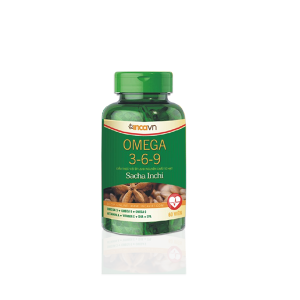The Useful of Omega3 from Inca Oil
See table 3 for a comparison of sacha inchi oil and argan oil, which are both high in Omegas and have interesting marketing potential. Rosehip oil is also a competing product, as it is high in Omega-3. The most commonly used Omega-3 oils are fish oils.
Recommended use Take 15 ml (1 tablespoon) per day as a natural source of Omega 3. Season salads, soup, or pasta. Use the oil in vinaigrettes, mayonnaise, or for cooking. Can also be applied as nutritious oil on the body and hair. Store in a cool place protected from light. Once opened, consume preferably within 1 month. Properties extra virgin, cold pressed oil fairly and sustainably harvested in the Peruvian Amazon Rainforest a stable, plant-based oil rich in Omega 3 organic, raw, vegan & gluten free.
The climbing plant grows in the Andes at an altitude of 200 to 1000 meters. The oil that is extracted from the star-like nut is very precious. Each capsule fruit has four to six corners. In every corner, there is a seed, the actual nut. The nuts are harvested, dried, and processed into flour or oil. It is important that the Sacha Inchi oil is cold-pressed so that all valuable ingredients and their effects are preserved.
What do the omega-3 fatty acids do in the body?Omega-3 and Omega-6 fatty acids are burned for energy in the body. In addition to generating energy, messenger substances are formed that have a decisive effect on health:• Cell membranes that contain a lot of omega 3 are much more pliable. For example, red blood cells can do much better slide through the capillary, which improves blood circulation.• Prostaglandins and thromboxanes are messenger substances of the omega-3 fatty acids. Messenger substances formed from the Omega 3have anti-inflammatory effects.• They have a positive effect on blood lipid levels and have been shown to lower harmful LDL cholesterol.• They have a blood pressure lowering effect and prevent platelet aggregation.
Abstract Sacha inchi seed oil is a promising substance for applications in food, pharmaceutical, and nutraceutical industries because of its valuable components, particularly omega-3. In this research, sacha inchi oil was extracted from the seed kernels using supercritical carbon dioxide (CO2) extraction compared with Soxhlet extraction. The influences of extraction time, type of solvents (hexane, ethanol, butanol, and i-propanol), and solvent volume on the oil yield and compositions were investigated in the Soxhlet. In the supercritical CO2 extraction, the effects of extraction time, temperature, and pressure were evaluated. The physicochemical properties of sacha inchi oils extracted with supercritical CO2 were characterized. Scanning electron microscopy (SEM) equipped with energy dispersive X-ray analysis (EDX), Fourier transform infrared (FTIR) spectroscopy, thermogravimetric analysis (TGA), and differential scanning calorimetry (DSC) were also carried out. The results showed the advantage of using supercritical CO2 extraction to increase the omega-3 content in the extracted oil within a shorter extraction time. The omega-3 content of 46.08% was obtained from the supercritical CO2 extraction at 400 bar and 60 °C. Supercritical CO2 extraction is a safe and environmentally friendly method that yields a toxic-free oil. Keywords: Extraction; Inca nut; Linoleic acid; Linolenic acid; Omega-3; Sacha inchi; Supercritical carbon dioxide.
Sacha inchi has a competitive advantage because it has a rare and popular fatty acid composition. This reduces the threat of substitution. It also has an interesting marketing story, with its exotic origin and traditional production by local communities.
Sacha inchi seeds are rich in nutrients and essential fatty acids, much more than other oilseed plants known. This plant is cultivated mainly in the district of Pichanaqui ( Junin - Peru) at the heart of the Inca culture because this land offers the best environmental conditions (the ground is soft and has a high content of minerals and some nutrients). This land is located at a high altitude - 500 meters above sea level - in the conjunction of the Andes and the Amazonian jungle. The place is protected from excessive rain, flooding, and hard winds. Sacha inchi was a wild plant but today it is grown in the Amazonian jungle. The Amazonian jungle is one of the most valuable in the world, it contains thousands of animal and vegetal species and it represents today more than one fifth of the world's freshwater reserves. The growth of the Sacha inchi plant contributes to the economy and health of the local people.
Bibliography
Enhancement of omega. (1970). Retrieved on April 19, 2022, from https://pubmed.ncbi.nlm.nih.gov/35097230/.
Exporting sacha inchi oil to Europe | CBI. (1970). Retrieved on April 19, 2022, from https://www.cbi.eu/market-information/natural-ingredients-cosmetics/sacha-inchi-oil.
SACHA INCHI. (1970). Retrieved on April 19, 2022, from https://www.palforess.eu/en/sacha-inchi-oil-omega-3/.
INKAnaturaL. (1970). Sacha Inchi Oil, Nuts, Inca Peanuts, Rich in Omega 3. Retrieved on April 19, 2022, from https://www.inkanatural.com/en/sachainchi/sacha_inchi_oil.html.
Martera. (1970). Organic Inca Inchi oil. Retrieved on April 19, 2022, from https://martera.com/en/product/inca-inchi-oil/.

